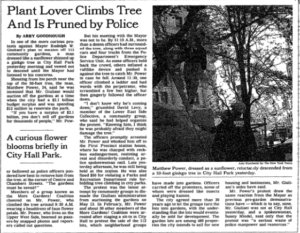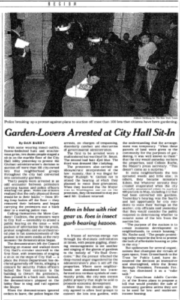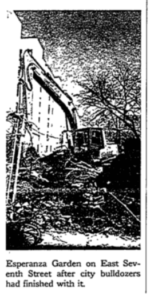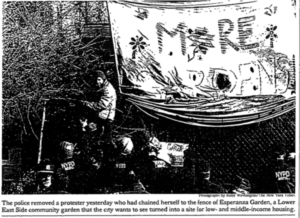As I continue to dive further into the history of Loisaida, I have become captivated with its community gardens. The gardens, which can be found on nearly every other block, are the fruitful product of a dark past- the lots they occupy are of buildings that were abandoned and burnt down by landlords during the housing crisis of the 70’s. The Loisaida community, along with their Bronx and South Harlem counterparts, saw the opportunity in the open spaces that these buildings left, and using nothing but the resources immediately available to them as well as volunteer labor, transformed these spaces into open productive spaces. The gardens served as cultural centers, meeting places for activists, and even sources of food- nurturing a bleeding neighborhood physically as well as spiritually.
As the neighborhood continued to develop, and gentrify, these gardens became a target for government intervention and attack. These gardens not only represented the resiliency of a community in the face of administrative neglect, but also represented a connection between the neighborhood and the homeland- serving as a means to preserve the Latino, specifically Puerto Rican, roots of Loisaida. Designed in direct parallel to the gardens of Puerto Rico, these spaces, in their nature, are subversive of the whitewashing of the neighborhood and have served as a first line of defense against gentrification. As a result, they are a threat to the vision of capitalist developers.
Starting in the 90’s, specifically under Rudy Giuliani’s mayorship, initiatives to reclaim these gardens and convert them into luxury high rises started to gain traction. Consequentially, so, too, did activist movements in protection of the gardens rise up. One of these groups, The More Gardens Coalition, holds the current residency at the Loisaida Center and has generously allowed me to work with them occasionally for the last three weeks. As this winter marks the coalition’s 20th anniversary, much of my work has centered around browsing through archived local newspaper articles that mentioned both their defeats (such as their effort to protect L’Esperanza garden, which was ultimately demolished despite the sprit of the coquí) as well as their victories (such as Giuliani’s announcement in May of ’99 that he would sell the majority of the gardens to an environmental group under which they would be protected. [Please see attached images for examples of New York Times articles addressing the work of More Gardens Coalition.]
While these articles continue to be an excellent primary source, I have turned to Miranda Martinez’s Power at the Roots: Gentrification, Community Gardens, and the Puerto Ricans of the Lower East Side as my main informant for my current research. Published in 2010, this book is a firsthand account of the author’s experience engaging with gardeners. activists, and residents of Loisaida- beginning in 1999. Not only does the timeline of this work line up perfectly with my research with More Gardens, which has been inherently more environmentally focused (especially because their current project is the development of an eco-city in upstate New York) but Martinez’s focus on the connection between the gardens and preserving the Latinidad of the Lower East Side is the perfect link between More Gardens and my research at Loisaida Inc. Martinez takes the time to embrace the contradictions of the neighborhood during the first decade of the 21st Century, and dive into the ways that Puerto Rican culture has been actively and intentionally erased despite this community being the one that built and preserved the neighborhood in the face of absolute neglect.
Citation: Martinez, Miranda J.. Power at the Roots : Gentrification, Community Gardens, and the Puerto Ricans of the Lower East Side, Lexington Books, 2010. ProQuest Ebook Central, https://ebookcentral-proquest-com.proxy.library.nyu.edu/lib/nyulibrary-ebooks/detail.action?docID=634252.





I’m really excited that you are working with More Gardens for the summer. One of the things I find exciting about the LES, which is not as prevalent in other NYC communities, is the strength of the community gardening movement. Could you think or reflect a bit more on the idea of gardeners as artists in residence? In what way is gardening the work of making art? And could you also think through the idea of gardening as a radical act, particularly in an urban space. For example (and I’m sure Martinez gets at this), what is being grown and what does that say about those who are gardening? How do we think about land use in terms of other things, like profit-making, residential use, etc. that are often in opposition to the idea of cultivating growing things? Super-interesting reflections so far!